PsychNewsDaily Publishers
100 Summit Drive
Burlington, MA, 01803
Telephone: (320) 349-2484
PsychNewsDaily Publishers
100 Summit Drive
Burlington, MA, 01803
Telephone: (320) 349-2484
Indoor cats require enrichment to prevent boredom and destructive behavior, promoting physical health, mental stimulation, and strengthening the bond with their owners through interactive play.
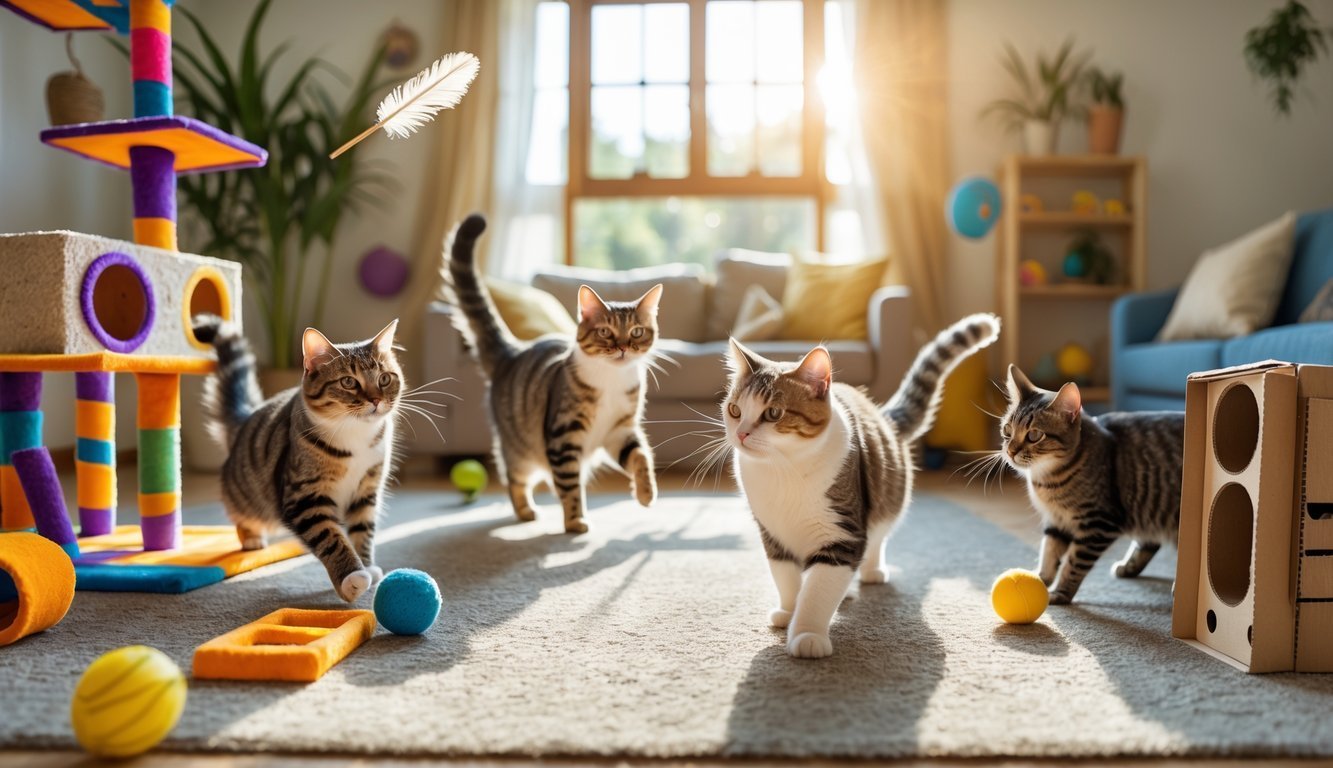
Keeping a cat indoors feels safer, but let’s be honest—it means you have to get creative to keep them entertained. If cats don’t get enough stimulation, they might get bored, restless, or even a little destructive. Indoor enrichment lets your cat stay playful, curious, and honestly, just happier while living inside.
You don’t need a huge apartment or fancy gadgets to make your cat’s life more interesting. A few simple activities, some creative setups, and a couple of interactive toys can really change things up. Here are 15 enrichment ideas that can help your cat stay happy for hours.
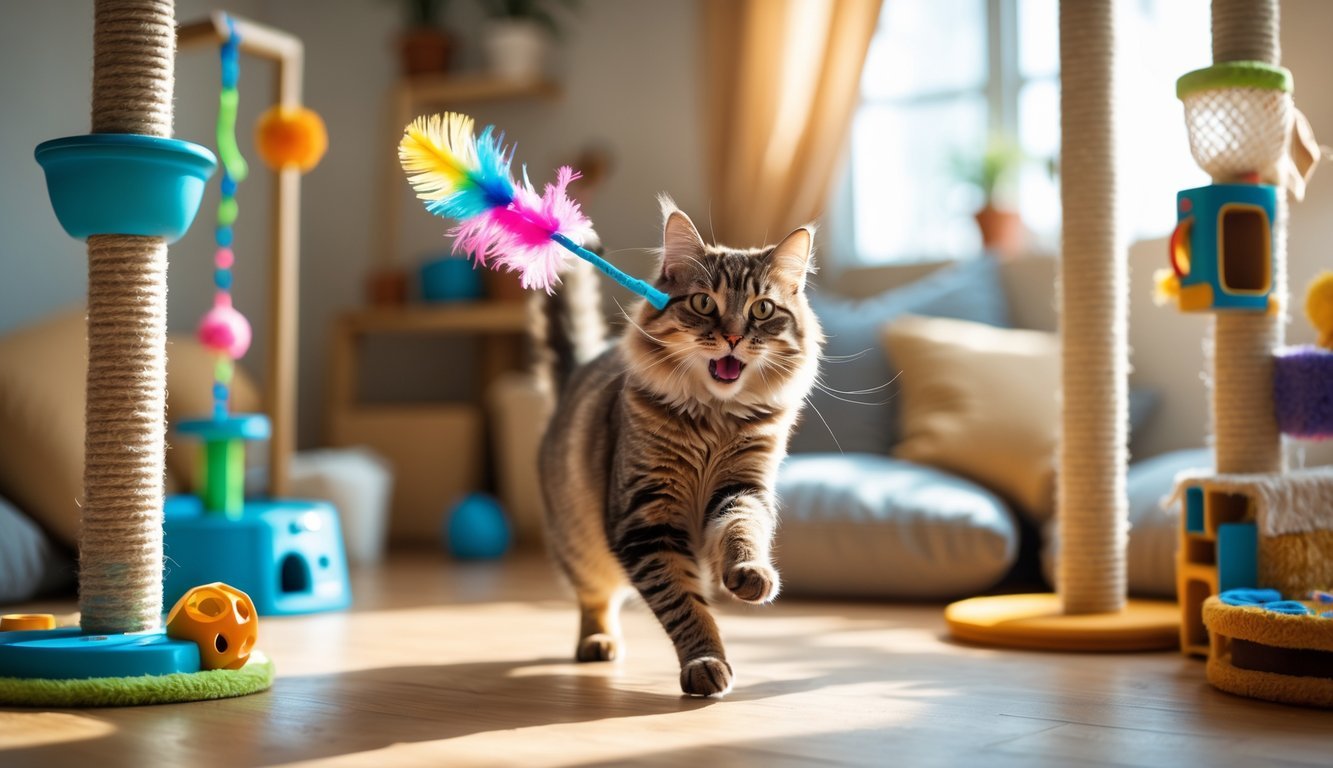
A feather wand is such an easy way to get your cat moving. Just wave the wand, and the feathers act like prey. That triggers your cat’s natural hunting instincts.
Guide the wand across the floor, dart it around corners, or lift it into the air. If you change the speed and direction, your cat will stay on their toes. Short, quick flicks usually get the most excitement.
These play sessions give your cat a great workout. Chasing, jumping, and pouncing help them burn off energy and keep their muscles strong. Even five or ten minutes a day makes a difference.
Playing together with the wand builds your bond too. Your cat starts linking playtime with you, not just the toy. That can really boost trust and cut down on boredom.
When the feathers wear out, just swap in a new attachment. Lots of wands have replaceable tips, so you don’t have to buy a whole new toy. That way, you keep things fresh for your cat.
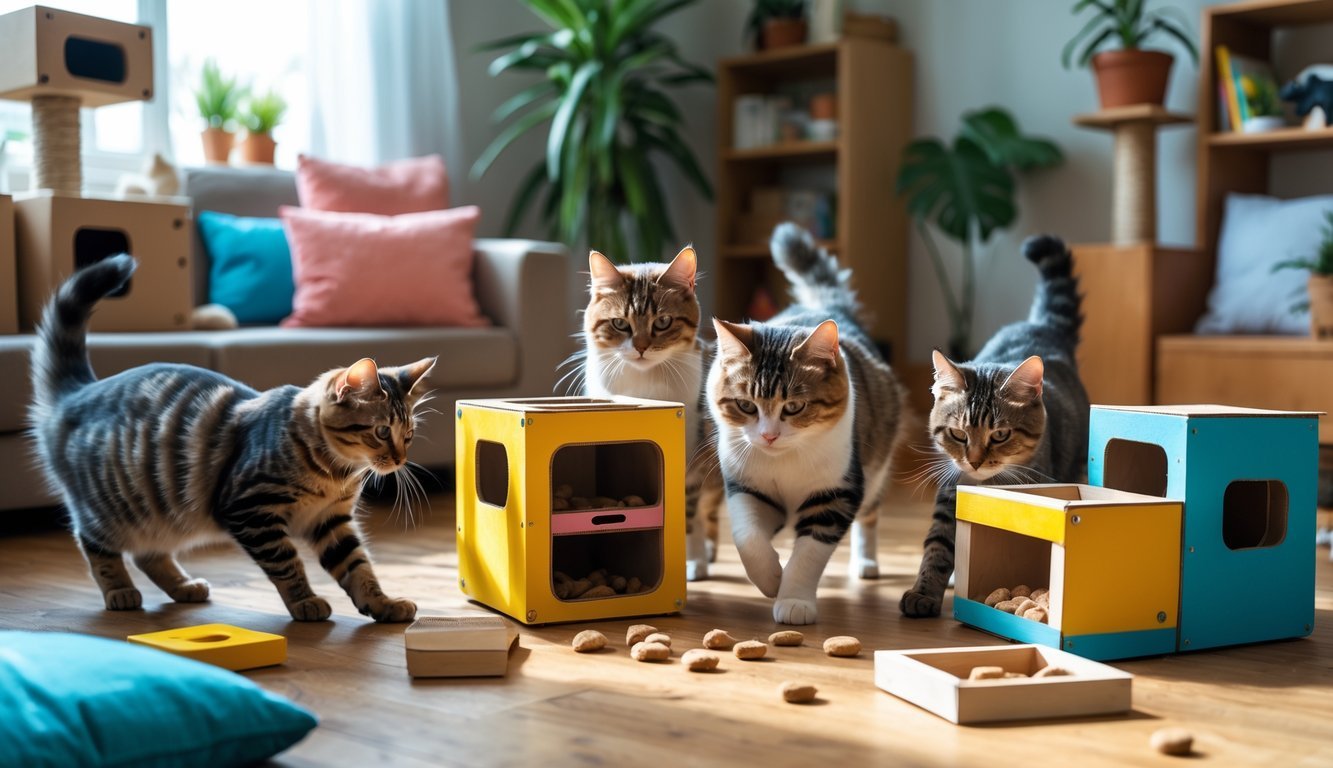
You can make a treat puzzle box with stuff you already have—cardboard boxes, empty toilet paper rolls, or any small container. Cats love the challenge of fishing out hidden treats.
Cut holes in a box just big enough for a paw, then toss in some treats or kibble. Your cat will have to reach in and scoop them out, which keeps them busy and thinking.
If you want to mix it up, stand toilet paper rolls upright in a shallow box. Drop treats into a few rolls and let your cat fish them out. It’s a simple way to encourage problem-solving.
Change the design every few days. Swap boxes, make the holes bigger or smaller, or hide treats in new spots. Little tweaks keep your cat curious and motivated.
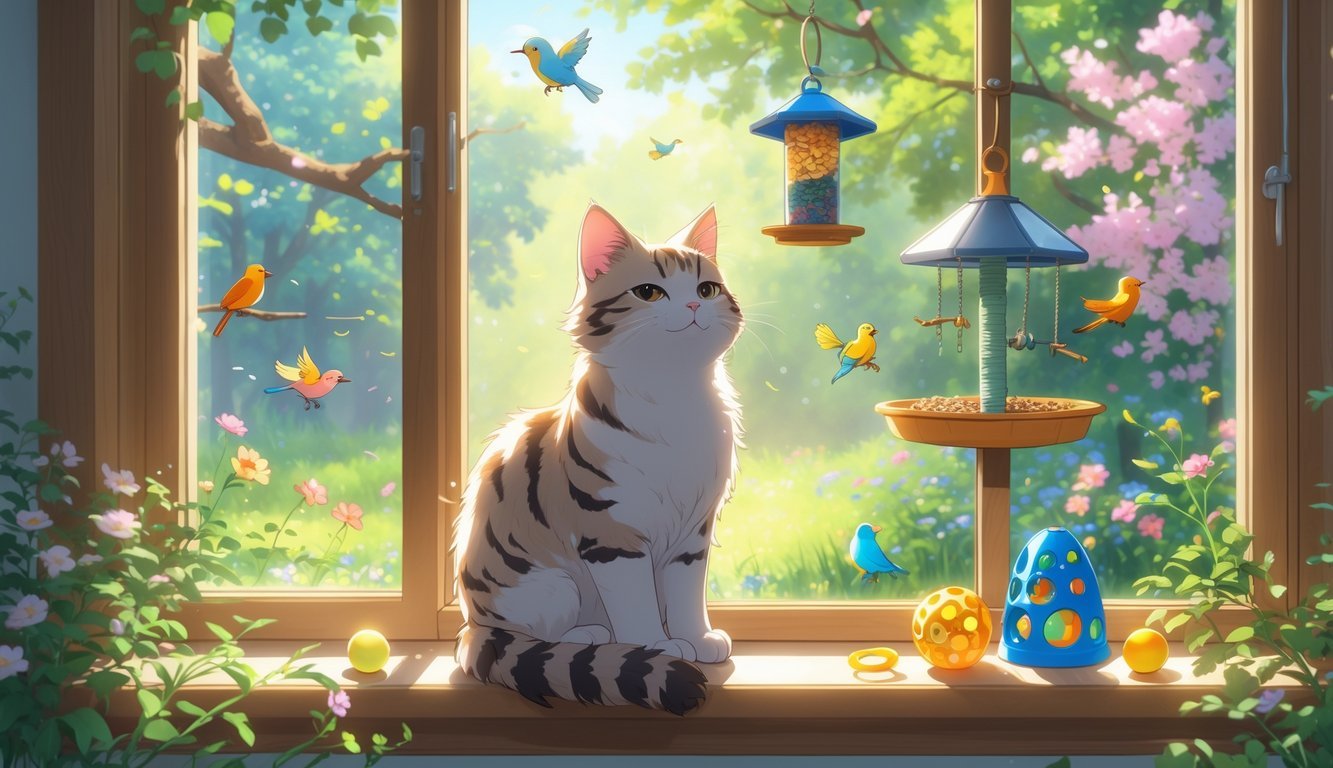
Give your cat a window perch for a safe, comfy spot to watch the world. You can stick one right on the window or set up a sturdy shelf with a blanket. Cats love these cozy lookout spots.
Put a bird feeder outside the window to make things even more interesting. Birds flying in give your cat something to watch, and the movement keeps them entertained.
Make sure the perch is solid and can hold your cat. Add a soft pad or blanket so they’ll want to lounge for a while. Hang the feeder where birds feel safe, but high enough so your cat can’t reach.
Even if you’re in an apartment, a small feeder will attract birds or squirrels. Over time, your cat might spend hours quietly watching. It’s a simple way to cut down on boredom and stress.
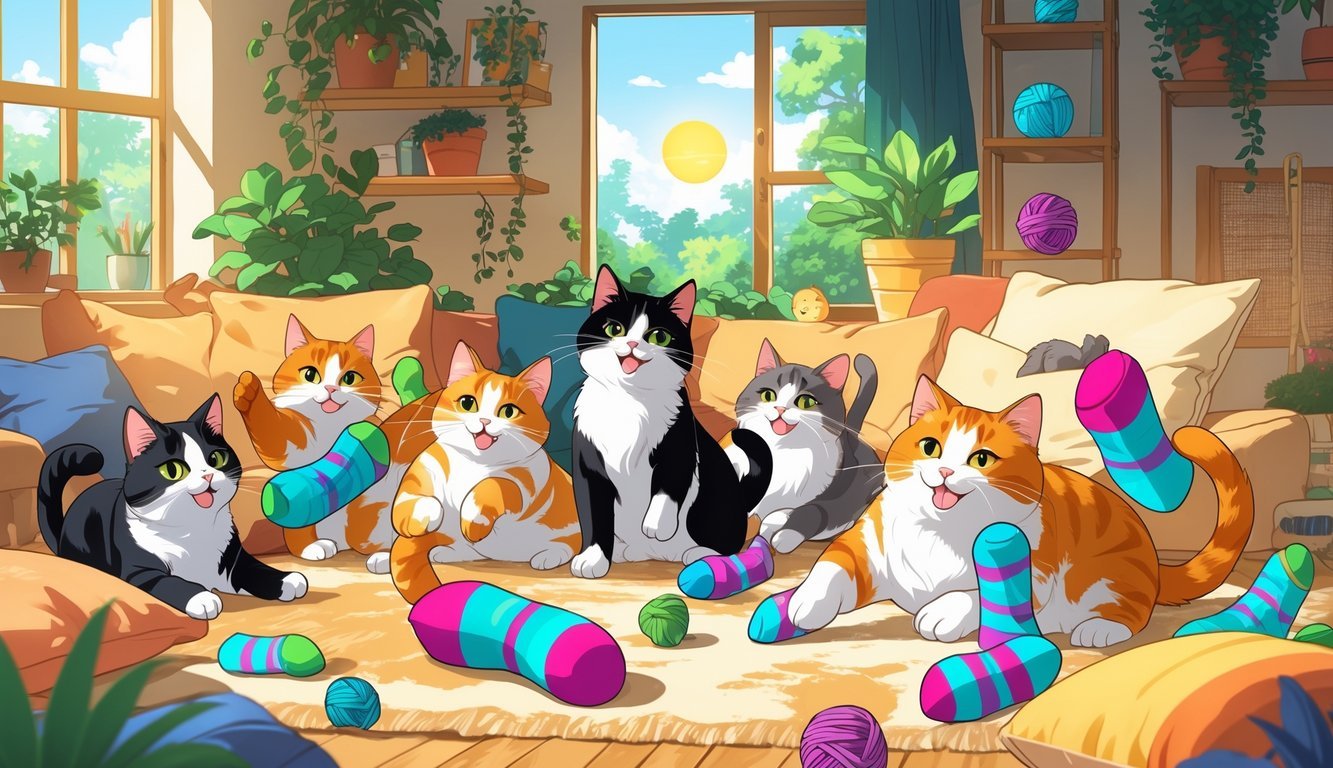
You can turn an old, clean sock into a fun toy with just a bit of catnip. It’s quick, cheap, and gives your cat something soft to wrestle and kick.
Fill the sock with dried catnip and tie a knot at the end. You can add some cotton or fabric scraps to make it a little bulkier.
Your cat might bat it around, hug it, or use it as a kicker. The catnip scent usually gets them playing and helps them stay active indoors.
When the scent fades, just add more catnip. Socks are easy to replace, so make a few and swap them out to keep things interesting.
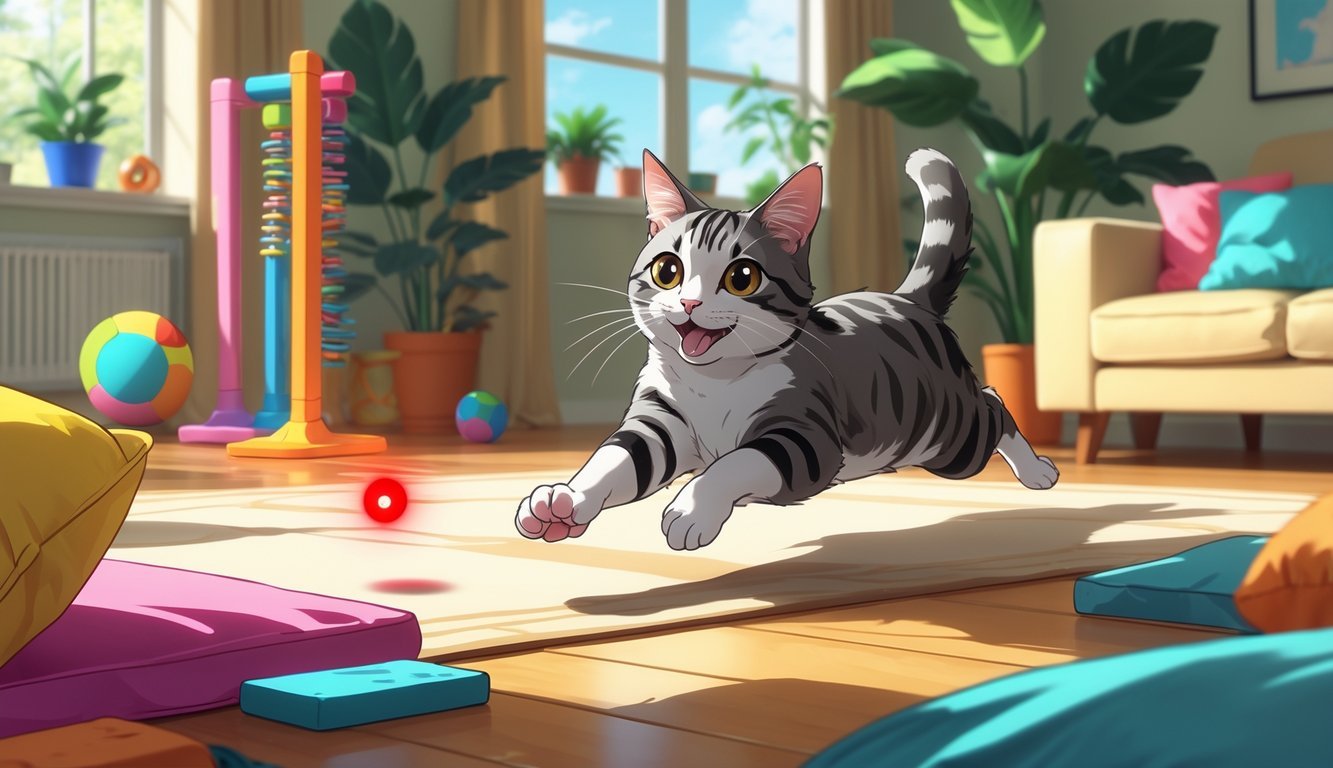
A laser pointer is one of those toys that gets your cat moving fast. The darting light brings out their hunting side, so they’ll run, pounce, and zigzag all over.
Keep sessions short—maybe 10 or 15 minutes—so your cat stays into it and doesn’t get frustrated. It’s usually better to have a couple of short chases a day.
Try moving the light in different patterns. Run it up the wall, across the floor, or around furniture to keep your cat guessing.
Always finish by letting your cat “catch” something real, like a toy or treat. That way, they don’t get frustrated chasing just a light.
Laser play works best as part of a mix. Pair it with toys your cat can actually grab so they get both mental and physical payoff.
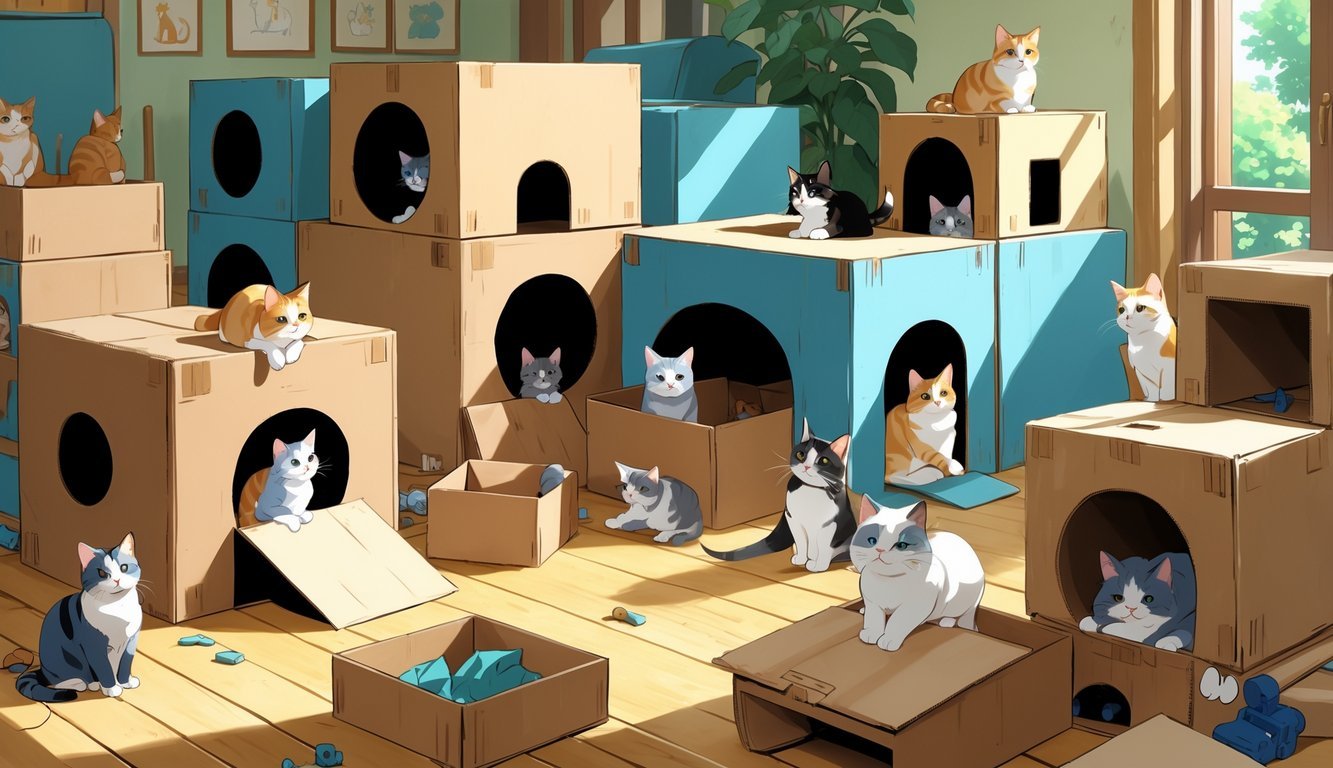
You can make a maze for your cat out of cardboard boxes. Cut entry and exit holes, then connect the boxes in different ways. Cats love exploring the tunnels and peeking through the holes.
Change the layout sometimes. Move boxes around or add a new one to keep things fresh. That little bit of variety keeps your cat interested.
Hide a toy or treat inside the maze to encourage your cat to explore. They might crawl, hide, or pounce as they figure out the new setup.
If you don’t have much space, even just two or three boxes work. You don’t need a giant maze—just a safe place for your cat to play and explore.
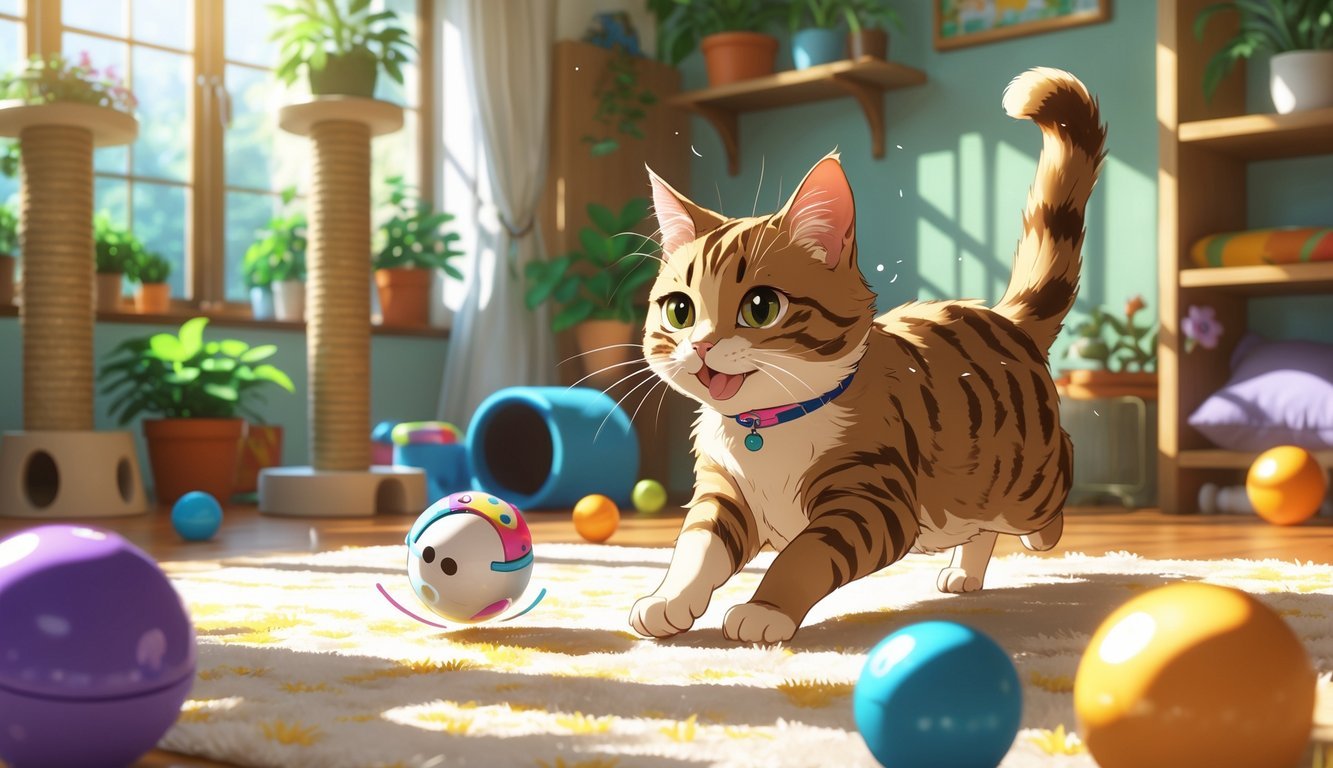
Automated ball chaser toys are great for giving your cat a chase when you’re busy. These little motorized balls roll around on their own, keeping your cat entertained.
Pick a model with lights, tails, or different speeds to grab your cat’s attention. Some even change direction when they hit something, which keeps things unpredictable.
Since the toy moves by itself, your cat gets both mental and physical exercise. That’s handy if you’re out for a while or just need a break.
Most are rechargeable, so you won’t have to keep buying batteries. Just charge them up and let your cat go wild.
If your cat gets bored easily, rotate this toy with others. Automated balls work best on smooth floors where they can roll freely.
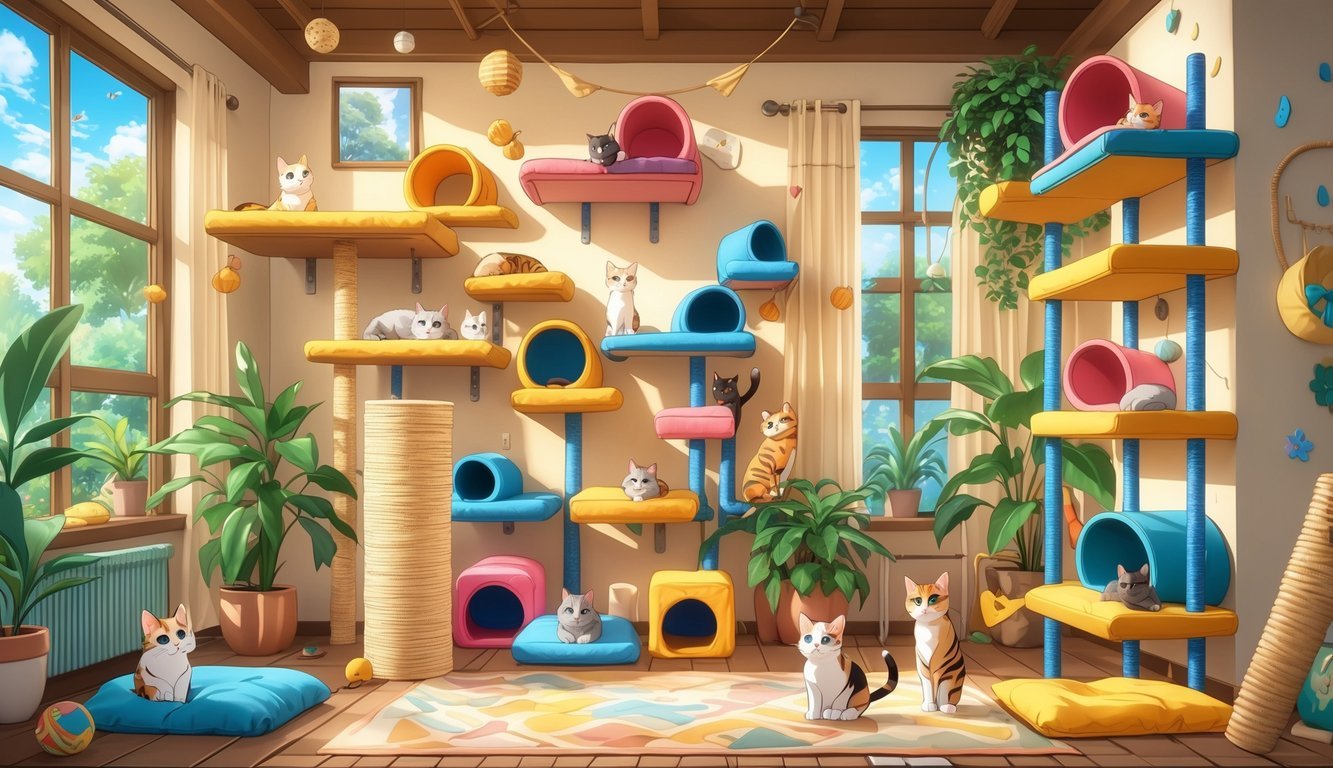
Wall-mounted shelves let your cat climb and explore without taking up floor space. You can place them at different heights to make a path along the wall. Lots of cats love hanging out up high.
You’ll find shelves in all kinds of styles, from simple planks to full climbing systems with bridges and hammocks. Some even have scratching boards, so you can mix and match.
This setup is perfect if you live in a small space. Instead of a big cat tower, you use the wall to give your cat more room. Your place stays less cluttered, and your cat gets more exercise.
Pick shelves that are sturdy and safe. Make sure they’re mounted well and can hold your cat’s weight. That way, your cat can climb, jump, and nap without worry.
Start with one or two shelves and add more as your cat gets used to them. You can keep expanding to keep things interesting. Wall shelves are a flexible, fun way to add enrichment.
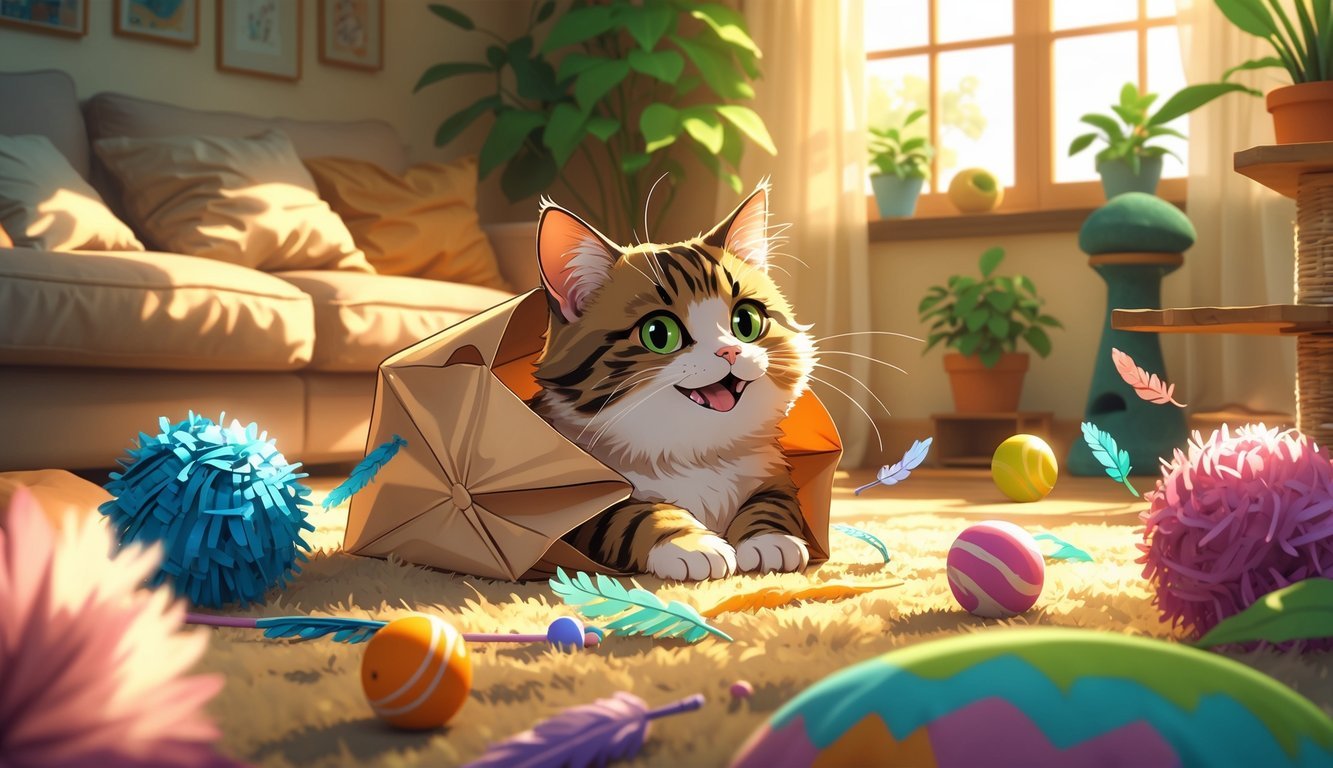
A paper bag can turn into a fun hide-and-seek game for your cat. Just put an open bag on the floor and let your cat check it out. The crinkly sound and hidden space really spark their curiosity.
Hide a small toy or a couple of treats inside the bag. Your cat will dig around and paw at it, tapping into their hunting instincts.
Try putting out a few bags at once. Leave some empty and put treats in others so your cat never knows what to expect.
Always watch your cat while they play. Skip plastic bags—stick with sturdy paper bags without handles for safety.
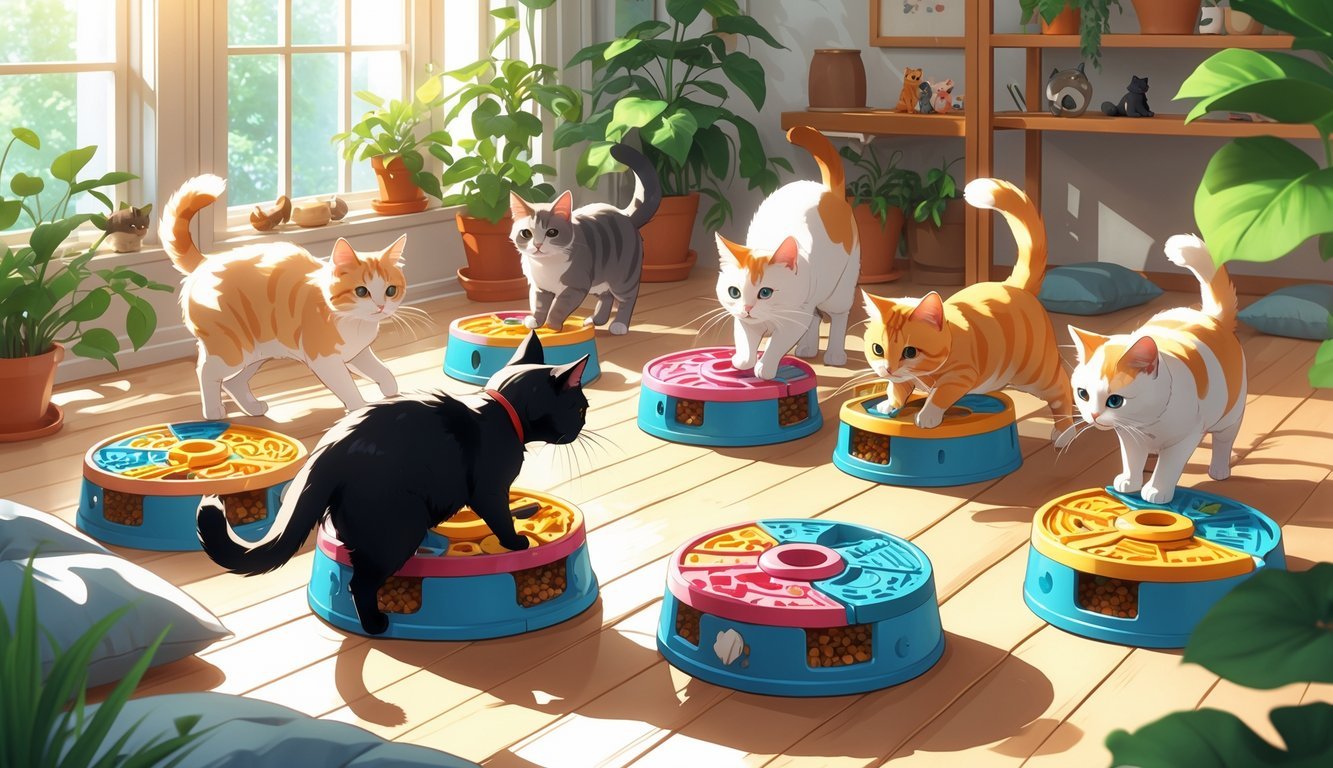
Puzzle feeders turn meals into a game. Instead of a boring bowl, your cat has to work a bit to get their food. That keeps their mind busy and slows down fast eaters.
Rotate different types of puzzle feeders to keep things fun. Switch between ball feeders, maze trays, and treat-dispensing toys. Changing them up helps prevent boredom.
Try hiding puzzle feeders around the house. Your cat gets to explore and move more, even during meals. Start with easy spots and make it harder as your cat gets the hang of it.
Rotating feeders also lets you see which ones your cat likes best. Some cats love batting things around, others like pawing food out of tiny holes. Offering variety gives your cat both mental and physical challenges every day.
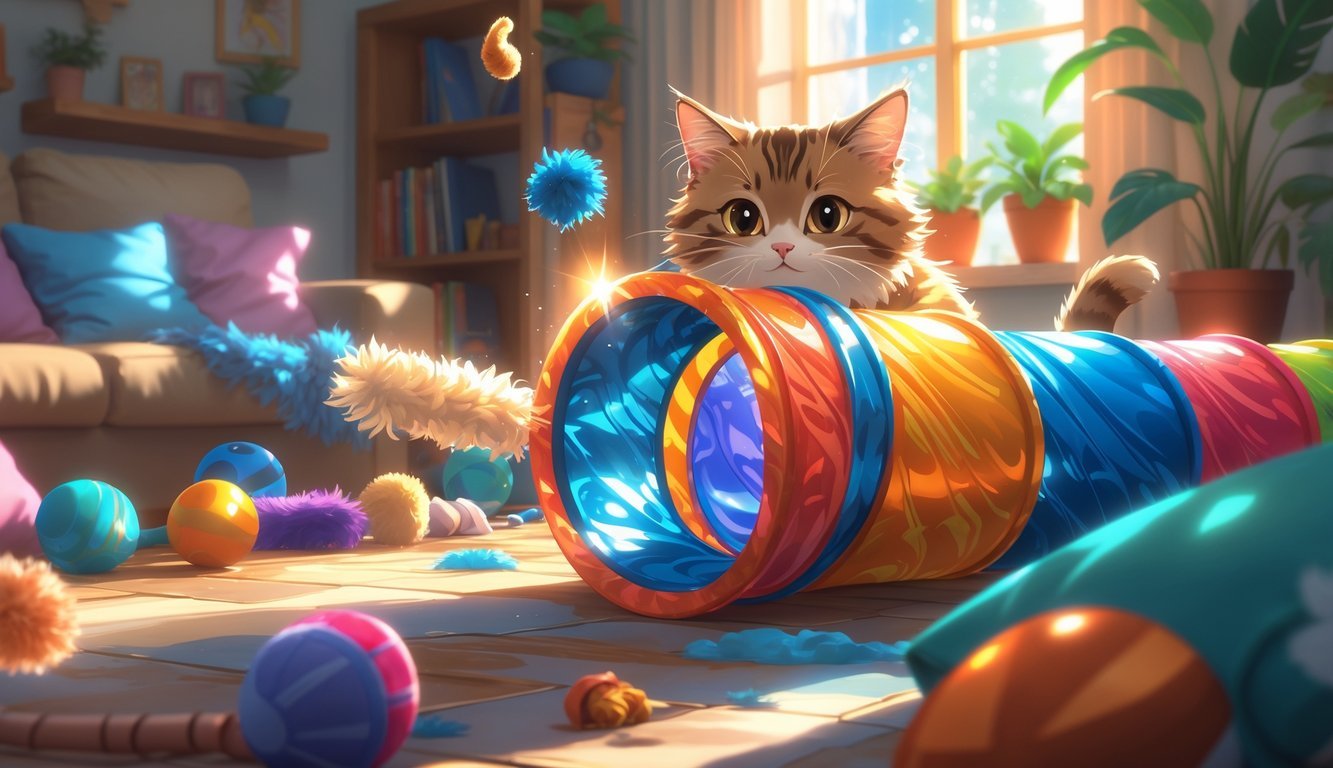
A crinkle tunnel gives your cat a safe spot to crawl, hide, and play. That crinkly sound? It adds a bit of extra excitement and keeps your cat curious.
It’s simple, but it really can hold your cat’s attention for a surprising amount of time.
Put the tunnel in the middle of the room for running, or tuck it by the couch for a sneaky hideout. Most cats love darting in and out, burning off energy and staying active indoors.
Try moving the tunnel to a new spot every few days. A fresh location makes it feel new again and encourages your cat to explore.
You can even connect more tunnels together for a longer play route. That’s always a hit.
Toss a ball or feather toy inside to make it even more fun. A little target at one end can spark your cat’s chasing and pouncing instincts.
This setup lets your cat practice hunting skills in a safe, indoor way.
If your cat is shy, the tunnel can become a cozy hiding place. It gives them comfort but still offers enrichment.
It’s useful for both play and rest, which is honestly pretty great.
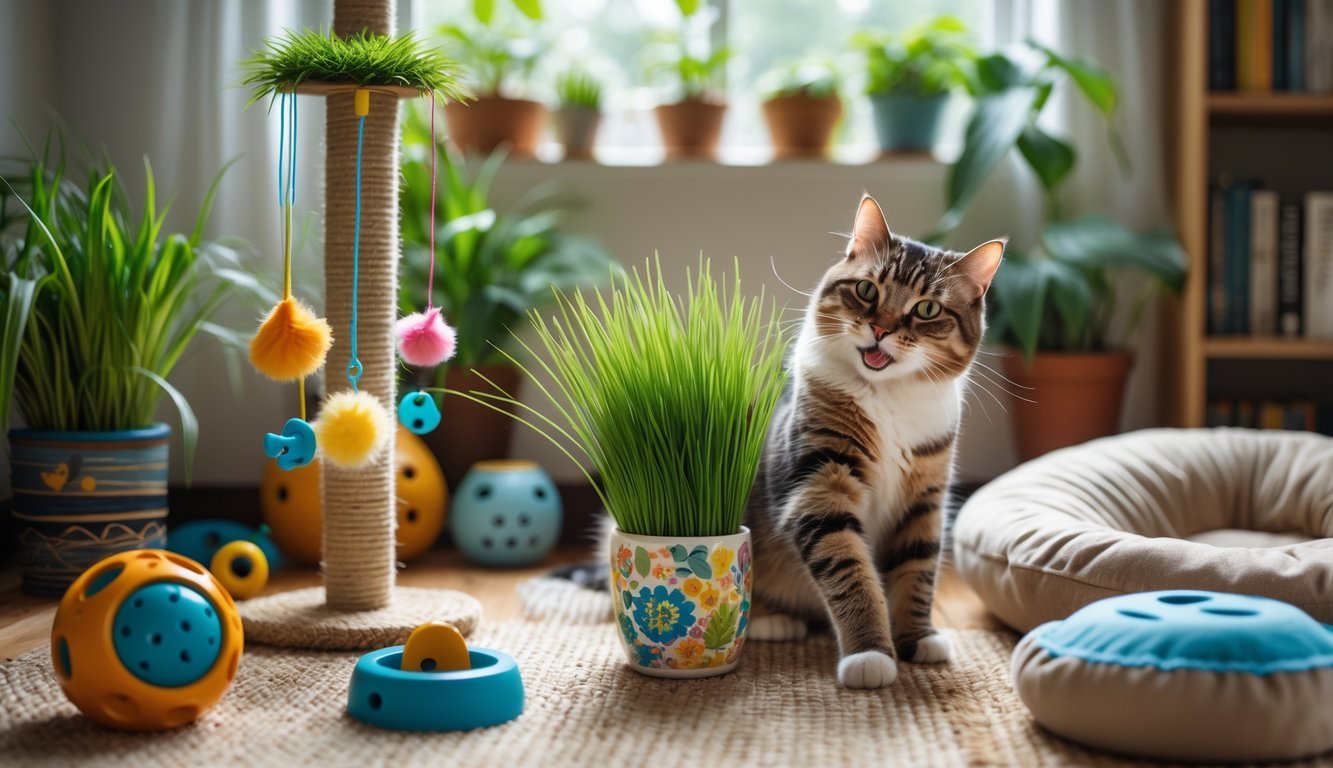
Bringing in cat-safe plants gives your cat something new to sniff and explore. Cat grass, spider plants, and Boston ferns are good picks—they won’t hurt your cat if they nibble.
Cat grass is especially popular. Lots of cats seem to love chewing on it.
It’s easy to grow in small pots, and it provides a safe outlet for that urge to munch on greenery.
Put pots of cat grass near a sunny window or on a shelf your cat can reach. This creates a little enrichment corner for sniffing, pawing, and grazing.
Safe plants add variety to your cat’s world. They offer fresh textures and scents without the dangers of toxic plants like lilies or pothos.
Swap out or refresh the plants now and then to keep things interesting. You might notice your cat coming back to them often, especially when they’re bored.
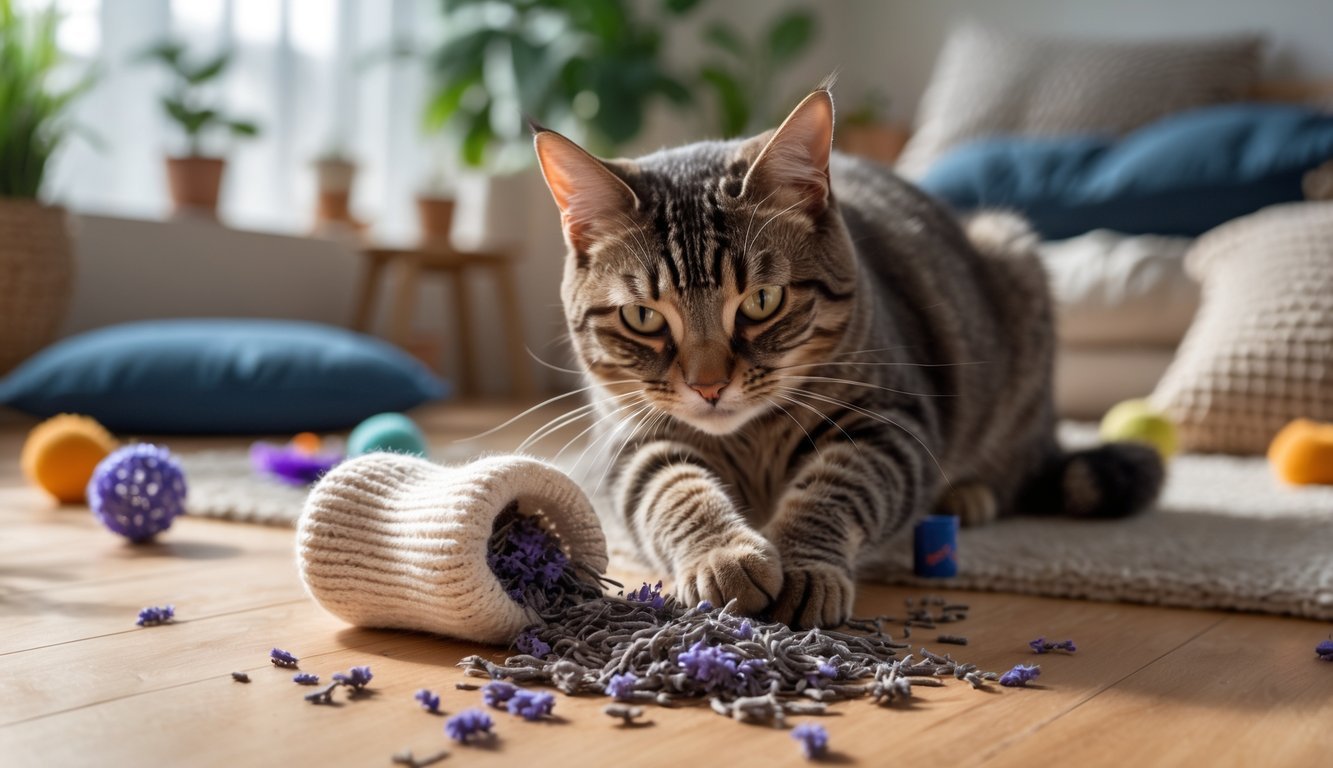
Grab an old sock and fill it with dried lavender to make a simple toy. The soft fabric is easy for your cat to bat, kick, or even carry around.
Lavender gives off a light scent that many cats find calming. It’s a gentle sensory experience—not too strong.
Just make sure you use fully dried lavender so it doesn’t get messy inside the sock.
To make the toy, put a handful of dried lavender in the sock and tie a knot at the open end. You can double-knot it or use a second sock for extra strength.
Offer the lavender sock during playtime or when your cat seems restless. Watch how your cat reacts—some love it, some don’t.
If your cat isn’t interested, try other dried herbs like valerian or catnip.
This activity is quick, cheap, and gives your cat something new to check out. It’s a fun way to reuse old stuff and add variety to play.
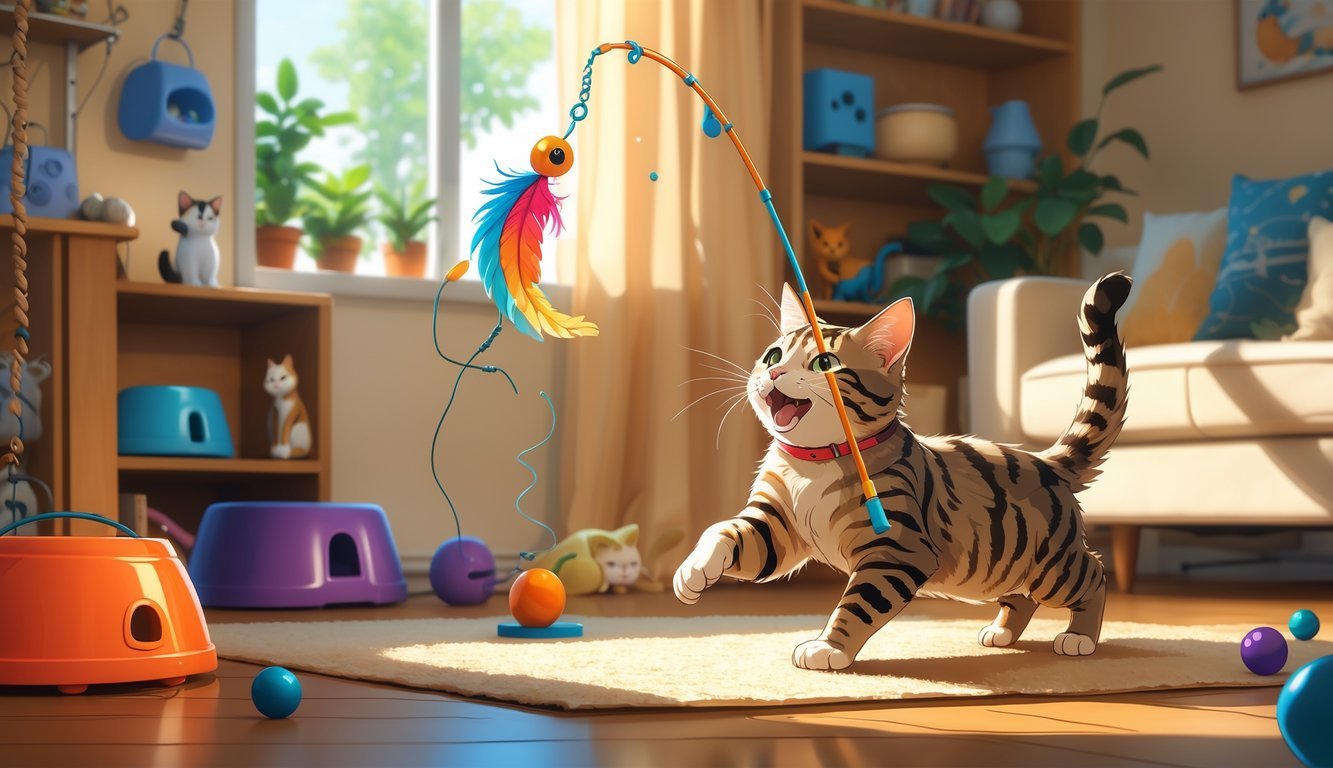
Fishing pole toys make it easy to play with your cat. Usually, it’s just a rod with a string and something dangly—think feathers or a little plush—that your cat can chase.
Move the toy in quick or unpredictable ways to mimic prey. That keeps your cat focused and gives them both mental and physical exercise.
It’s also a great way to let them burn off extra energy.
You can buy these toys at pet stores, but honestly, making one at home is simple. Grab a stick, some ribbon, and a felt toy, and you’re set.
Always check for loose parts so your cat stays safe during play.
These toys don’t take up much space and you can stash them away when you’re done. Bringing them out at random times keeps things fresh and exciting.
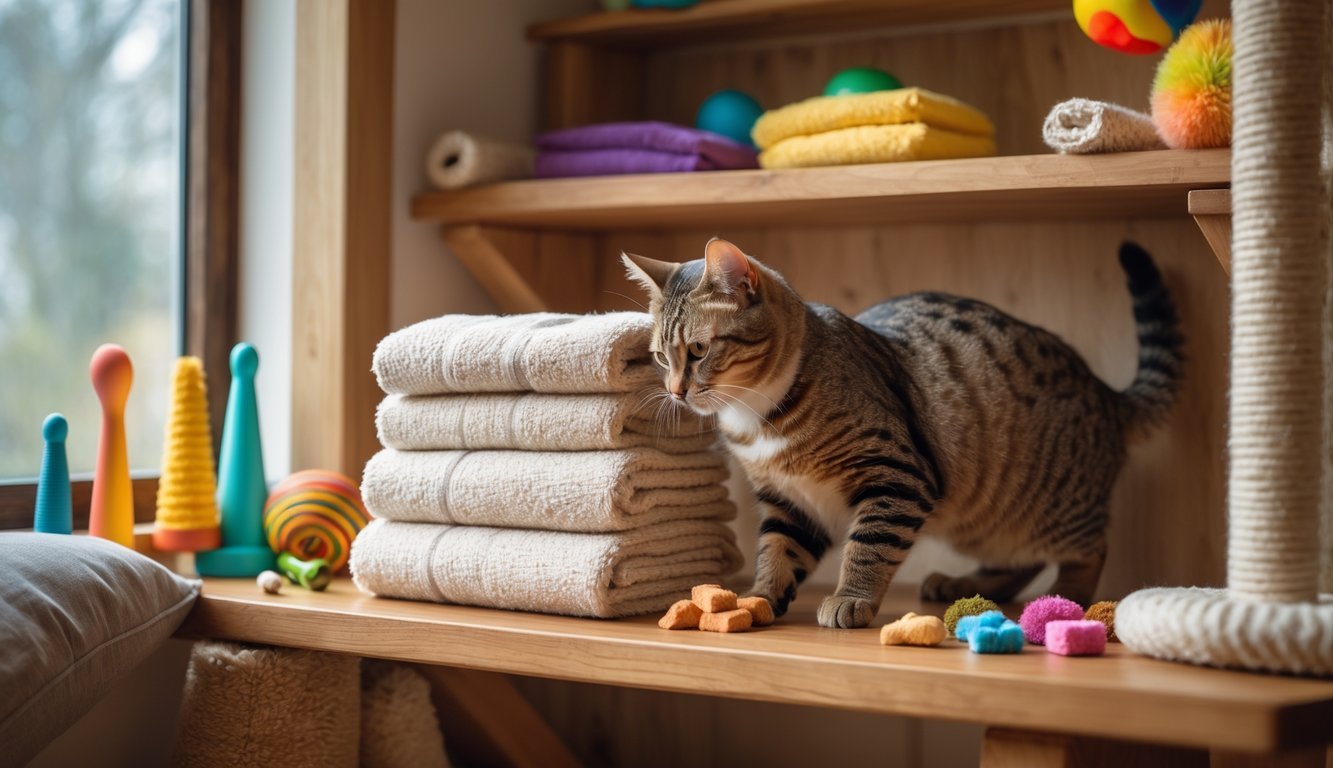
Turn a regular towel into a little puzzle for your cat. Fold it a few times and tuck treats between the layers.
Your cat will sniff, paw, and dig to find the snacks.
This taps into your cat’s natural foraging instincts. Searching for food is fun for them, and this setup provides both mental and physical stimulation.
You don’t need any fancy equipment.
Make it harder by folding the towel more tightly or adding extra layers. If your cat is new to this, start with loose folds so they can figure it out quickly.
Over time, you can up the challenge.
Always use treats that are safe for cats, and keep an eye on them the first few times. You want them to stay engaged, not get frustrated.
It’s a cheap, easy way to make playtime more interesting.
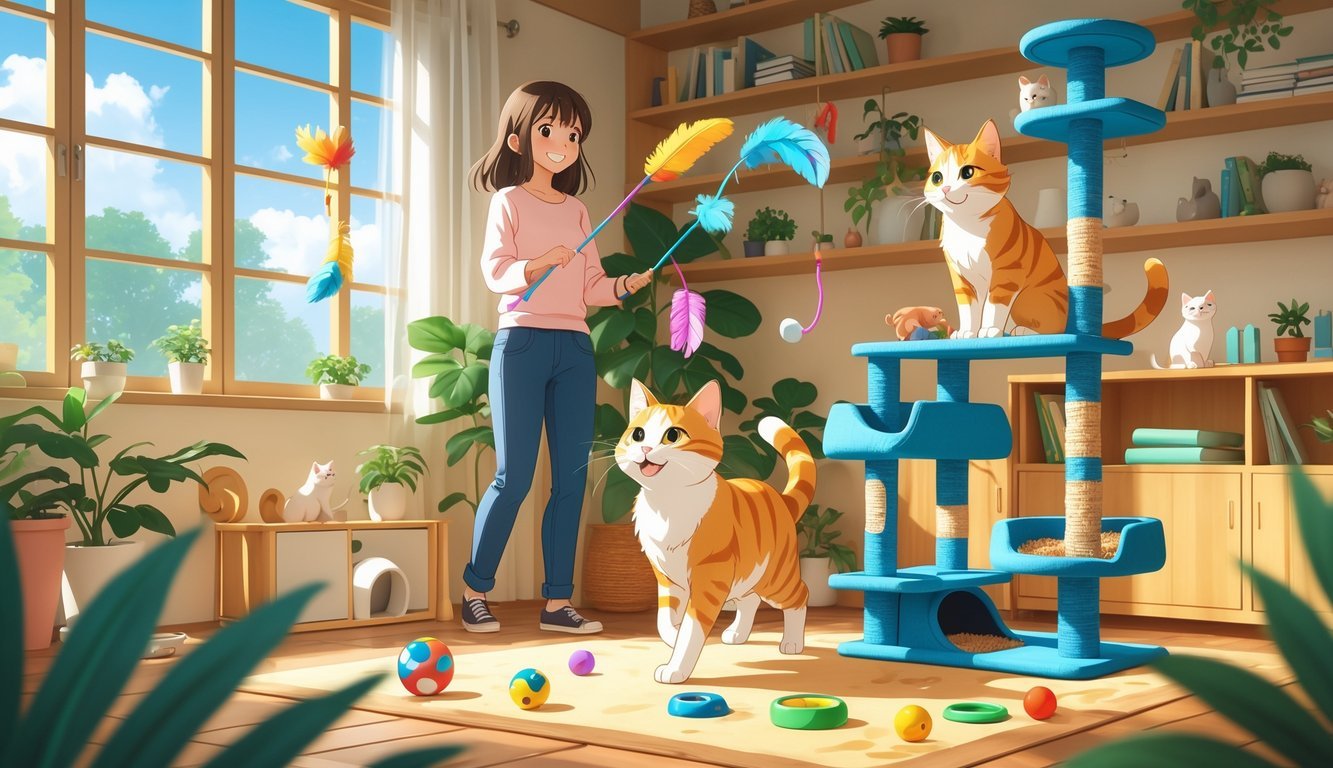
Indoor cats depend on you for exercise, play, and stimulation. If they don’t get enough activity, they can end up with health problems, stress, or even start acting out.
Your cat needs daily movement to stay strong. Indoor enrichment encourages exercise, which helps control weight, keeps muscles toned, and lets joints stay flexible.
Climbing, chasing toys, or scratching posts all give your cat healthy ways to act on their instincts.
Obesity is a big risk for indoor cats. Extra weight can lead to diabetes, heart disease, and sore joints.
Play sessions and interactive toys help your cat burn calories and avoid those issues.
Enrichment supports natural instincts, too. Scratching, climbing, and pouncing aren’t just fun—they keep claws healthy, improve balance, and help cats stay agile.
Even a few short play sessions each day can make a real difference in your cat’s physical health.
Cats need more than just physical exercise. They crave challenges that keep their minds busy.
Puzzle feeders, treat-dispensing toys, or hiding food around the house all give your cat chances to problem-solve and stay engaged.
Boredom can lead to stress, anxiety, or destructive habits like scratching the furniture. Mental stimulation helps prevent frustration and helps your cat feel safer at home.
Enrichment also strengthens your bond. When you play together with wand toys or teach simple tricks, you build trust and give your cat positive attention.
A mentally engaged cat is usually more relaxed and less likely to act out.
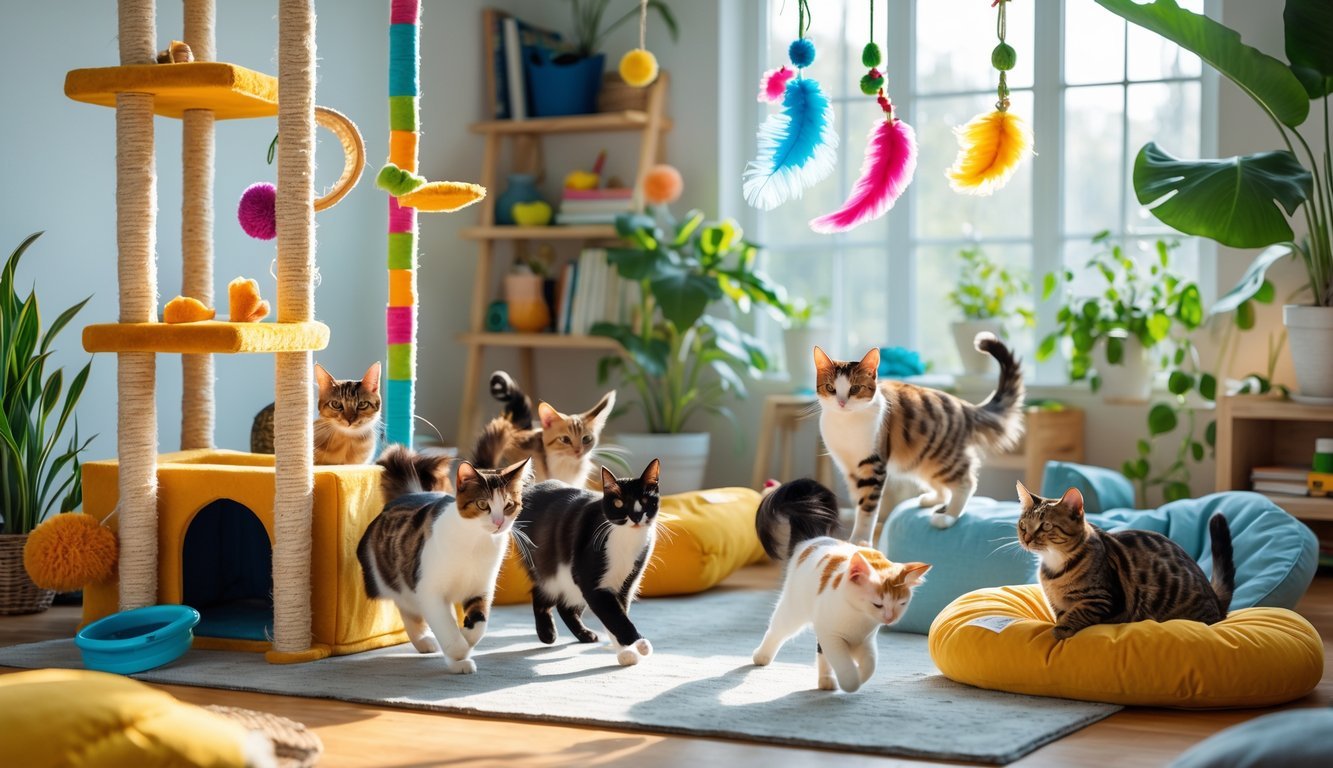
A fun indoor space for your cat works best when it’s safe and interesting. Choose the right toys and arrange the room so your cat can climb, hide, and explore.
Pick toys made from non-toxic, pet-safe materials. Stay away from things with loose strings, sharp edges, or small parts your cat could swallow.
Soft plush toys, sturdy plastic balls, and felt mice are usually safe.
Rotate toys every few days to keep things fresh. Store extras in a bin and swap them out so your cat doesn’t get bored.
Interactive toys like wand teasers or feather chasers let you join the fun. These get your cat moving and help you bond.
Puzzle feeders are great too—they mix play with snack time.
If you’re into DIY, use cardboard boxes, paper bags without handles, or crumpled paper balls. Just double-check for staples, tape, or anything that could hurt your cat.
Cats love climbing and hanging out up high. When you add a cat tree, wall shelves, or a window perch, you’re giving your cat some safe territory off the ground.
These spots help lower stress and give your cat a better view of what’s going on.
Hideaways matter, too. Little covered beds, tunnels, or even a box can offer your cat a quiet place to escape when they’ve had enough.
Try putting hideouts in a few different rooms so your cat has choices.
If you can, set up vertical spaces near windows. Most cats can’t resist watching birds or whatever’s happening outside.
Mixing climbing spots with cozy hideaways makes your home feel more balanced for your cat. They’ll have places to play, explore, or just nap—whatever suits their mood.